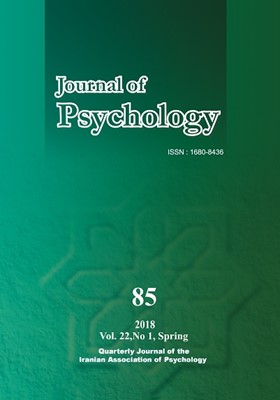Compare Flow State Experience (Peak Performance) in Elite and Non-Elite Iranian Athletic
Subject Areas : PsychologyMohamad Amin Jalilvand 1 , Rasoul Roshan 2 , Maryam Esmailinasab 3 , Rasoul Hemayttalab 4
1 - Faculty of Psychology and Education University of Tehran, I.R. Iran
2 - Shahed University, Tehran, Iran
3 - Tarbiat Modares University, Tehran, Iran
4 - Faculty of Psychology and Education University of Tehran, I.R. Iran
Keywords: flow state, peak performance, athletice, lite and non-elite, sport psychology,
Abstract :
The purpose of this study was to compare selected flow state experience (peak performance) in elite and non-elite Iranian athletic. This study examined relationships between peak performance, and flow state. The flow-feeling theory helps in understanding the reason people do activities in maximum (peak performance)and extremely motivated state. The elite sample included 55 and non- elite 50 females and males (with 23.5 in average) athletic. They were interviewed and questioned, Flow State Scale-2-Chen, Hung (DFS_2) was used for data collection. The t-test revealed a significant difference between elite and non-elite athletic in 4 factor, and totale flow state, and five others. Some results indicate to there can be a state of flow on the athletic. However, elite athletic were better than non- elite athletic in all catagorys. According to the results of this study, it is recommended that elite athletic.
بشارت، محمدعلي؛ عباسي، غلامرضا؛ شجاعالدین، صدرالدين(1381). بررسي رابطه بين عزتنفس و موفقيت ورزشي در فوتبالیستها و كشتي گيران. نشریة حركت، 12، 44-31.
واعظ موسوي،سيدمحمدكاظم. مسيبي،فتح اله (1386) روانشناسي ورزشي. تهران: سمت.
فرخی احمد(1392)”تعيين روايي و پایایی نسخةفارسي مقياس کمالگرایی ورزشي درجامعة ورزشكاران ايران: رشد و یادگیری حرکتی– ورزشی، 11، 56.
Asakawa, K. (2004). Flow experience and autotelic personality in Japanese college students: How do they experience challenges in everyday life? Journal of Happiness Studies, 5(2), 123–154.
Asakawa, K. (2010). Flow experience, culture, and well-being: How do autotelic Japanese college students feel, behave, and think in their daily lives? Journal of Happiness Studies, 11(2), 205–223.
Bandura, A. (2006). Guid for constructing self-efficacy scales. In F. Pajares, T. Urdan (Eds.), Selfefficacy beliefs of adolescents (pp. 307-337).
Carter, L., River, B., & Sachs, M. L. (2013). Flow in sport, exercise, and performance: A review with implications for future research. Journal of Multidisciplinary Research, 5(3), 17.
Csikszentmihalyi, M. (1988). Optimal experience: Psychological studies of flow in consciousness. Cambridge University Press.
Csikszentmihalyi M.(2008). Flow: The psychology of optimal experience. New York, NY: Harper Perennial.
Seligman, M. E., & Csikszentmihalyi, M. (2014).Positive psychology: An introduction (pp. 279-298). Springer Netherlands.
Chen, Y.-J., Hung, T.-M., Lin, T.-C., Li, C.-L., Chang, C.-W., & Lin, S.-C.(2003). Confirmatory factor analysis of the Chinese version of Flow State Scale-2. Journal of Sport & Exercise Psychology, 25 (Suppl.).
Dietrich, A. (2004). Neurocognitive mechanisms underlying the experience of flow. Consciousness and Cognition, 13(4), 746–761.
Engeser, S. & Rheinberg, F. (2008). Flow, performance and moderators of challenge-skill balance. Motivation and Emotion, 32, 158-172.
Jackson, S. A., & Csikszentmihalyi, M. (1999).Flow in sports. United States of America: Human Kinetics.
Jackson, S.A., & Eklund, R.C. (2002).Assessing flow in physical activity: The Flow State Scale-2 and Dispositional Flow Scale-2. Journal of Sport and Exercise Psychology, 24, 133-150.
Jackson, A., Eklund, R., & Martin, A. (2008).Assess the optimal psychological state of flow. Revisado en Noviembre 2015.
Kee, Y.H., & Wang, C.K.J. (2008). Relationships between mindfulness, “flow dispositions and mental skills adoption: A cluster analytic approach. Psychology of Sport and Exercise, 9, 393-411.
Mao, Y., Roberts, S., Pagliaro, S., Csikszentmihalyi, M., & Bonaiuto, M. (2016). Optimal experience and optimal identity: A multinational study of the associations between flow and social identity. Frontiers in Psychology, 7.
Mosing, M. A., Magnusson, P. K. E., Pedersen, N. L., Nakamura, J., Madison, G., & Ullén, F. (2012a). Heritability of proneness for psychological flow experiences. Personality and Individual Differences, 53(5), 699–704.
Nakamura, J., & Csikszentmihalyi, M. (2014).The concept of flow. In Flow and the foundations of positive psychology (pp. 239-263).Springer Netherlands.
Nakamura, J., & Csikszentmihalyi, M. (2002).The concept of flow. In C. R. Snyder & S. J. Lopez (Eds.), Handbook of positive psychology (pp. 89–105).
Oliveira, H. Z., Gomes, V. F. P., & Miranda, R. (2015). The Flow State in Young Basketball Players. Psicologia em Estudo, 20(1), 95-106.
Ross, S. R., & Keiser, H. N. (2014). Autotelic personality through a five-factor lens: Individual differences in flow-propensity. Personality and Individual Differences, 59, 3–8.
Swann, C. (2016). Flow in Sport. In Flow Experience (pp. 51-64).Springer International Publishing.
Weinberg, R. S., & Gould, D. (2014). Foundations of Sport and Exercise Psychology, 6E. Human Kinetics.


